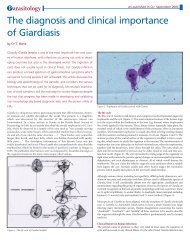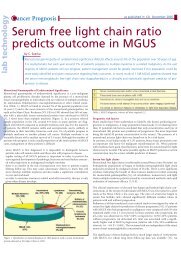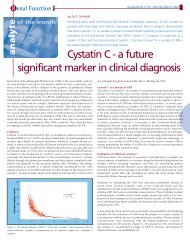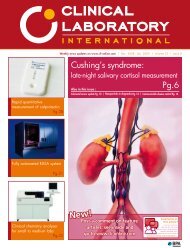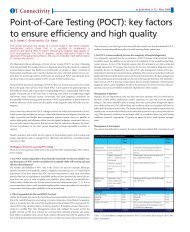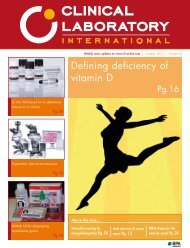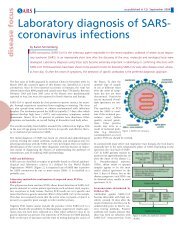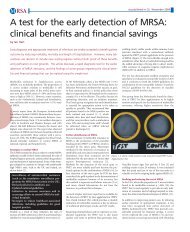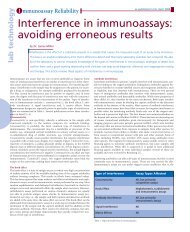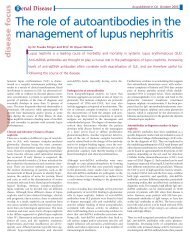Screening for cancer: are biomarkers of value?
Screening for cancer: are biomarkers of value?
Screening for cancer: are biomarkers of value?
Create successful ePaper yourself
Turn your PDF publications into a flip-book with our unique Google optimized e-Paper software.
– February/March 2011 14 Tumour markers<br />
Molecular <strong>for</strong>ms <strong>of</strong> prostate specific<br />
antigen (PSA) in serum: clinical and<br />
analytical implications<br />
Prostate specific Antigen (PSA) is widely used as a disease biomarker<br />
<strong>for</strong> diagnosis and monitoring <strong>of</strong> prostate <strong>cancer</strong> (PCa). Numerous<br />
different immunoassays <strong>are</strong> available <strong>for</strong> the measurement <strong>of</strong><br />
PSA and its sub<strong>for</strong>ms in serum. The assays can be referenced to<br />
different laboratory standards and <strong>are</strong> not interchangeable. Patients<br />
and physicians should be aw<strong>are</strong> <strong>of</strong> which assay was used, and<br />
longitudinal monitoring should be per<strong>for</strong>med with the same test.<br />
by Dr Katharina Braun, Dr David Ulmert and Dr Hans Lilja<br />
Prostate-specific antigen (PSA) is a kallikrein-related<br />
peptidase encoded by a five<br />
exon gene 7.1 kb (KLK3), one <strong>of</strong> fifteen<br />
genes clustered in a 280 kb locus on the long<br />
arm <strong>of</strong> chromosome 19 in the cytogenic<br />
region q13.3-4 [1]. KLK3 (encoding PSA)<br />
and KLK2 (encoding kallikrein-related<br />
peptidase 2 or hK2) sh<strong>are</strong> approximately<br />
80% amino acid sequence identity and the<br />
two proteins <strong>are</strong> produced and secreted at<br />
highly abundant levels by prostate epithelium<br />
although some expression can also<br />
be detected in certain other extra-prostatic<br />
tissues [2].<br />
PSA is synthesised as a 261-amino-acid<br />
(aa) pre-pro precursor that is processed to a<br />
non-catalytic zymogen through removal <strong>of</strong><br />
a ≈17-aa signal peptide upon transfer to the<br />
endoplasmic reticulum, whereas the short<br />
activation peptide must be released, e.g. by<br />
hK2, to convert the non-catalytic ≈244-aa<br />
zymogen to the mature 237-aa catalytic<br />
single-chain PSA [2].<br />
Originally called gamma-seminoprotein,<br />
a seminal fluid protein was identified in<br />
1966 and characterised in 1971 by Hara et<br />
al [3]. The authors anticipated that the protein<br />
would be a potential marker <strong>for</strong> seminal<br />
fluid applicable in the field <strong>of</strong> <strong>for</strong>ensic<br />
medicine. In 1979, PSA was purified from<br />
prostatic tissue, and was later found to be<br />
identical to gamma-seminoprotein [4]. Subsequently,<br />
several studies recognised PSA<br />
as a potential marker <strong>for</strong> PCa [5]. The first<br />
assay <strong>for</strong> PSA in serum was developed by<br />
Kuriyama et al [6] shortly after Papsidero<br />
and coworkers [5] identified PSA in blood.<br />
PSA is synthesised in normal prostate epithelium,<br />
benign prostate hyperplasia (BPH)<br />
and all stages <strong>of</strong> prostate adenocarcinoma.<br />
The concentration <strong>of</strong> PSA in seminal fluid<br />
is up to 10⁶ fold higher than in blood [7].<br />
The median concentration <strong>of</strong> tPSA in blood<br />
is ≈0.7 ng/mL in healthy men at early middle<br />
age [8], whereas in advanced <strong>cancer</strong> the<br />
amount <strong>of</strong> PSA in the blood can increase up<br />
to 10,000 fold [7].<br />
Although recent data from the large population-based<br />
randomised trials in Europe<br />
and the US have demonstrated that PSAbased<br />
prostate <strong>cancer</strong> screening can reduce<br />
mortality from prostate <strong>cancer</strong> by about half<br />
after fourteen years, these important benefits<br />
<strong>are</strong> tempered by considerable overdetection<br />
and consequential risks <strong>for</strong> overtreatment<br />
associated with current screening modalities<br />
[9]. Risk <strong>of</strong> prostate <strong>cancer</strong> diagnosis,<br />
metastasis and death from prostate <strong>cancer</strong><br />
<strong>are</strong> very strongly associated with concentration<br />
<strong>of</strong> PSA in blood [8]. This strong rationale<br />
explains the widespread use <strong>of</strong> PSA as a<br />
key biomarker to assess disease risk, monitor<br />
therapeutic intervention and disease<br />
recurrence and as a key component in<br />
various prognostic models.<br />
Molecular <strong>for</strong>ms <strong>of</strong> PSA in serum<br />
PSA added to blood in vitro exists in three<br />
<strong>for</strong>ms: one fraction will occur complexed with<br />
inactivating protease inhibitors, one portion<br />
as non-complexed non-catalytic PSA, and a<br />
third as active PSA entrapped by macroglobulins<br />
[10]. However, the “total PSA” (tPSA)<br />
detected in clinical samples comprises the<br />
sum <strong>of</strong> the concentration <strong>of</strong> both free PSA<br />
and PSA complexed to protease inhibitor<br />
ACT [11]. Data from the original discovery<br />
and characterisation <strong>of</strong> the proportion <strong>of</strong> free<br />
PSA versus PSA-ACT complexes suggested a<br />
mean free-to-total PSA ratio <strong>of</strong> 22% (range<br />
7-50%) in patient’s serum samples [11]. Based<br />
on PSA-measurements at early middle age<br />
in a large, highly representative populationbased<br />
cohort <strong>of</strong> men, the median proportion<br />
<strong>of</strong> free-to-total PSA in blood has later been<br />
shown to be ≈33% (IQR 28%; 38%) [12].<br />
Complexed PSA<br />
In the blood circulation, the majority <strong>of</strong> noncatalytic<br />
PSA is covalently complexed with<br />
the protease inihibitor α1-antichymotrypsin<br />
(ACT or SERPINA5). Active PSA can also<br />
be enveloped by α-macroglobulins such as<br />
α2-macroglobulin (A2M) and pregnancy<br />
zone protein (PZP) [10]. Unlike the interactions<br />
with ACT, the complex-<strong>for</strong>mation<br />
with A2M or PZP does not inactivate PSA<br />
although it blocks catalytic PSA from access<br />
to protein substrates [10]. It is noteworthy<br />
that such macromolecules mask epitopes recognised<br />
by commercially available assays and<br />
thus stay undetected by these methods [1,11].<br />
Since the original discovery in the early 1990s<br />
it has been c<strong>are</strong>fully documented that the proportion<br />
<strong>of</strong> PSA-ACT is higher in men with<br />
PCa comp<strong>are</strong>d to men with BPH [6,10], that<br />
the free-to-total PSA ratio is an independent<br />
predictor <strong>of</strong> prostate <strong>cancer</strong> risk [9], and that<br />
the free-to-total PSA ratio enhances discrimination<br />
<strong>of</strong> men with BPH from those with evidence<br />
<strong>of</strong> PCa beyond that <strong>of</strong> total PSA alone<br />
[13]. A systematic review and meta-analysis <strong>of</strong><br />
66 subsequent studies found that the free-tototal<br />
PSA ratio (“%fPSA”) enhanced the accuracy<br />
in predicting the diagnostic outcome <strong>of</strong><br />
a prostate biopsy comp<strong>are</strong>d to that based on<br />
tPSA alone [14].<br />
Free PSA and sub<strong>for</strong>ms<br />
The non-complexed, free PSA in blood<br />
is a mixture <strong>of</strong> different inactive <strong>for</strong>ms<br />
circulating unattached to any plasma<br />
proteins. These inactive <strong>for</strong>ms can be<br />
separated into two main fractions: single<br />
chain “intact” <strong>for</strong>ms with or without<br />
truncated remainders <strong>of</strong> the short activation<br />
peptide, and <strong>for</strong>ms that <strong>are</strong> inactive<br />
due to internal cleavages. The most



